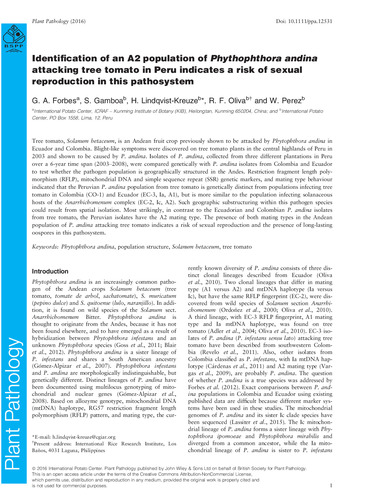Tree tomato, Solanum betaceum, is an Andean fruit crop previously shown to be attacked by Phytophthora andina in Ecuador and Colombia. Blight‐like symptoms were discovered on tree tomato plants in the central highlands of Peru in 2003 and shown to be caused by P. andina. Isolates of P. andina, collected from three different plantations in Peru over a 6‐year time span (2003–2008), were compared genetically with P. andina isolates from Colombia and Ecuador to test whether the pathogen population is geographically structured in the Andes. Restriction fragment length polymorphism (RFLP), mitochondrial DNA and simple sequence repeat (SSR) genetic markers, and mating type behaviour indicated that the Peruvian P. andina population from tree tomato is genetically distinct from populations infecting tree tomato in Colombia (CO‐1) and Ecuador (EC‐3, Ia, A1), but is more similar to the population infecting solanaceous hosts of the Anarrhichomenum complex (EC‐2, Ic, A2). Such geographic substructuring within this pathogen species could result from spatial isolation. Most strikingly, in contrast to the Ecuadorian and Colombian P. andina isolates from tree tomato, the Peruvian isolates have the A2 mating type. The presence of both mating types in the Andean population of P. andina attacking tree tomato indicates a risk of sexual reproduction and the presence of long‐lasting oospores in this pathosystem.
Identification of an A2 population of Phythophthora andina attacking tree tomato in Peru indicates a risk of sexual reproduction in this pathosystem
Citation: Forbes, G.A.; Gamboa, S.; Lindqvist-Kreuze, H.; Oliva, R.F.; Perez, W. 2016. Identification of an A2 population of Phythophthora andina attacking tree tomato in Peru indicates a risk of sexual reproduction in this pathosystem. Plant Pathology. (UK). ISSN 0032-0862. 65(7):1109-1117.
2016-04-11
CROP AND SYSTEMS SCIENCES CSS, CROP PROTECTION
SOUTH AMERICA
PERU
journal_article

